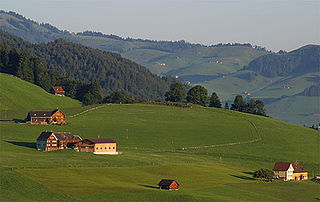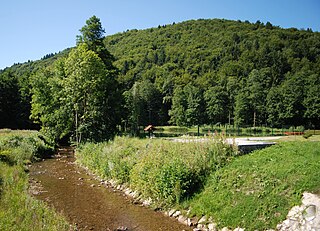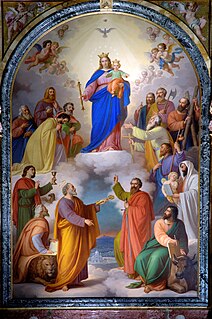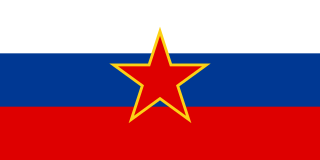
Lower Carniola is a traditional region in Slovenia, the southeastern part of the historical Carniola region.
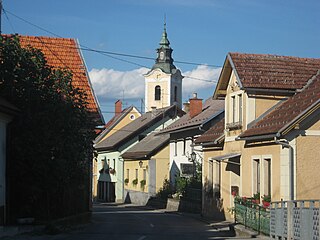
Semič is a settlement in southeastern Slovenia. It is the administrative centre of the Municipality of Semič.

Nova Štifta is a small settlement in the Municipality of Sodražica in southern Slovenia. The area is part of the traditional region of Lower Carniola and is now included in the Southeast Slovenia Statistical Region.

Gorenje Kamenje is a settlement in the hills north of the town of Novo Mesto in southeastern Slovenia. The entire Municipality of Novo Mesto is part of the traditional region of Lower Carniola and is now included in the Southeast Slovenia Statistical Region.

Ponikve is a clustered settlement in the Municipality of Tolmin in the Littoral region of Slovenia.

Vrtovče is a small village in the hills south of the Vipava Valley in the Municipality of Ajdovščina in the Littoral region of Slovenia.

Mirna is a nucleated village and a minor economic centre in central Lower Carniola, Slovenia. It is the largest settlement of the Mirna Valley and the centre of the Municipality of Mirna. It is situated at the crossing of regional roads and a confluence of several creeks with the Mirna River, along the railway line linking Sevnica and Trebnje.

Rogati Hrib is an abandoned settlement in the Municipality of Kočevje in southern Slovenia. The area is part of the traditional region of Lower Carniola and is now included in the Southeast Slovenia Statistical Region.

Tihaboj is a nucleated settlement in the local community of Gabrovka, Municipality of Litija, central Slovenia. It lies on a terrace in the Gabrovka Hills, a part of the Mirna Valley, along the road connecting Litija and Mirna. The landscape has a fluviokarst character. The settlement comprises the hamlets of Mlake, Orešje, and Psina. The residents mainly live from farming and service activities; many of them drive to work to nearby places.

Boštanj is a village in the Lower Sava Valley in southeastern Slovenia. It consists of a nucleated centre on two terraces on the right bank of the Sava River along the main road from Celje to Krško, and two hamlets, Puše and Redna, on the slopes of the nearby hills. It is the central settlement of the Local Community of Boštanj, the largest local community in the Municipality of Sevnica. The village has a post office, a fire station, a primary school, two shops, a gas station, two bars, a restaurant, and a cultural hall named the TVD Partizan Hall. It is surrounded by fields and orchards.

Kaplja Vas is a village in the Municipality of Sevnica in central Slovenia. The area is part of the historical region of Lower Carniola. The municipality is now included in the Lower Sava Statistical Region.

Laze pri Boštanju is a dispersed settlement in the hills south of Boštanj in the Municipality of Sevnica in central Slovenia. The area is part of the historical region of Lower Carniola. The municipality is now included in the Lower Sava Statistical Region. It includes the hamlets of Rekštanj and Zapuže.

Metni Vrh is a dispersed settlement in the hills north of Sevnica in east-central Slovenia. The area is part of the historical region of Lower Styria. The Municipality of Sevnica is now included in the Lower Sava Statistical Region.

Mrzla Planina is a dispersed settlement in the hills northeast of Sevnica in east-central Slovenia. The area is part of the historical region of Styria. The municipality is now included in the Lower Sava Statistical Region.

Vrh pri Boštanju is a settlement in the hills southwest of Boštanj in the Municipality of Sevnica in east-central Slovenia. The area is part of the historical region of Lower Carniola. The municipality is now included in the Lower Sava Statistical Region. The settlement includes the hamlets of Dule, Pleček, Gabrnik, Ravne, Topolovec, Grič, Hrib, Dobje, Reviše, Volčje Jame, Drče, Okič, Sleme, Drenovec, Straški Hrib, and Lipoglav.

Tržišče is a settlement along the road linking Mokronog and Sevnica in the Lower Carniola region in east-central Slovenia. It is part of the Municipality of Sevnica, which is included in the Lower Sava Statistical Region. St. George's Hill lies to the northwest of the village. The rail line from Sevnica to Trebnje runs through the settlement and has a station there. The settlement includes the hamlets of Mostec and Sveta Trojica.

Šmarčna is a settlement on the right bank of the Sava River in the Municipality of Sevnica in east-central Slovenia. The area is part of the historical region of Lower Carniola. The municipality is now included in the Lower Sava Statistical Region. The settlement includes the hamlet of Gomila.
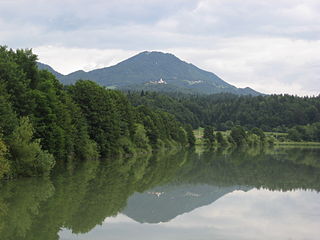
Lisca is a 948 m hill in the eastern part of the Sava Hills in southeastern Slovenia, northwest of Sevnica, north of the Sava, and south of Gračnica Creek. The hill offers a superb view. It is the most frequently visited hiking destination in the Sava Hills.

Jurij Moškon is a Slovenian film editor and photographer. He received the Vesna award, the main Slovenian recognition in the field of film.

Brezje is a small village in the Municipality of Sevnica in southeastern Slovenia. It lies on a small rise east of Krmelj and the village of Hinjce and west of the Mirna River. Until 2006, the area was part of the settlement of Goveji Dol. The village is part of the traditional region of Lower Carniola and is included in the Lower Sava Statistical Region. One of the two roads from Krmelj to the main road linking Mokronog and Sevnica runs through the settlement, in the valley south of the village core. A cattle trough stands on its right side at the crossroad leading from it into the village. It was built in the 1940s.

